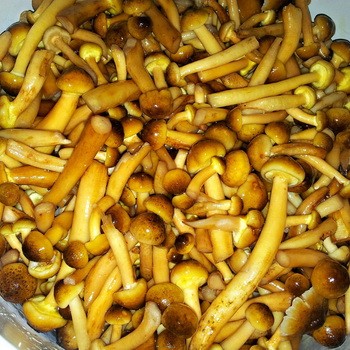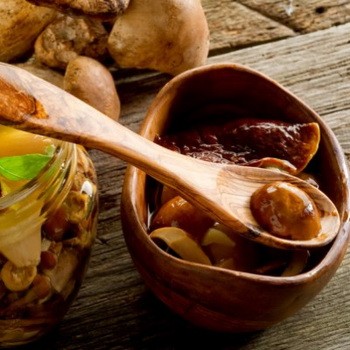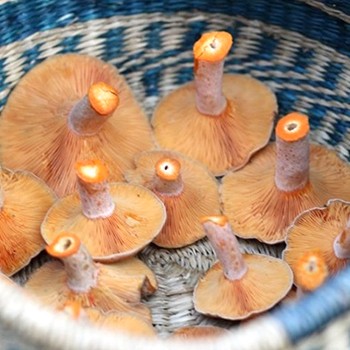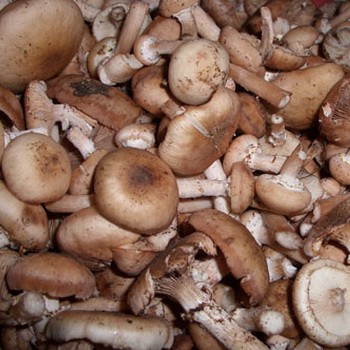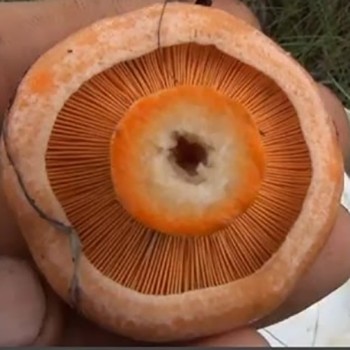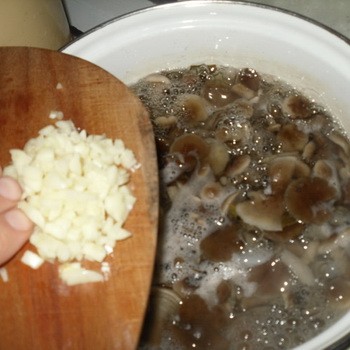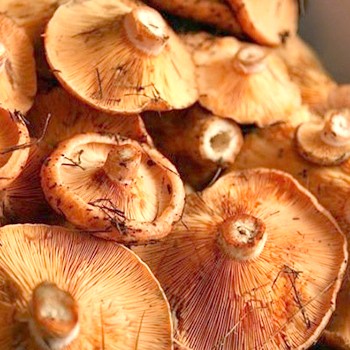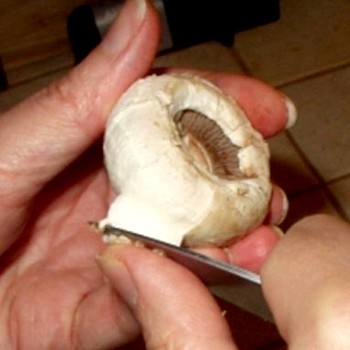Methods for processing honey mushrooms before cooking
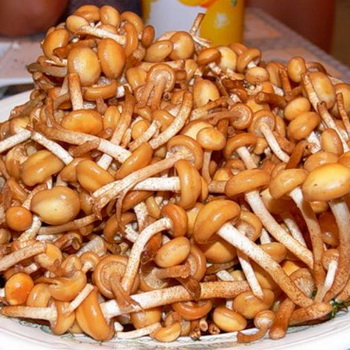
It is worth saying that the processing of mushrooms mushrooms does not take much time, because by themselves, these fruiting bodies do not grow on the ground. Therefore, forest debris accumulates very little on them, with the exception of fallen leaves and adhering grass. Honey mushrooms grow almost all year round, but the peak season for their collection falls on the September and October months.
In order to quickly carry out the initial processing of honey mushrooms at home before cooking and their further use, you should spend time in the forest cleaning. When you collect honey mushrooms, cut them closer to the hat, leaving a small part of the leg. It is better to put mushrooms in a basket, as in a bucket they begin to “sweat” and lose their shape. It is very important to be able to distinguish edible mushrooms from their false “brothers”: real mushrooms have a “ring-skirt” on their stalk.
Content
Processing honey mushrooms before freezing and drying
Fresh mushrooms have the property of darkening very quickly after cutting. Thus, immediately after harvesting, honey mushrooms are processed. If fruiting bodies are intended for drying, then they are not washed. Honey mushrooms are sorted by size, most of the legs are cut, and the hats are wiped with a dry kitchen sponge. Only then do they begin the drying process.
In the modern world, the preservation of products for the winter can be carried out by freezing. At home - this is the most popular way. So you can keep fresh not only berries, fruits and vegetables, but also mushrooms.
Before freezing, honey agarics are processed in the same way as before drying. First, the mushrooms are sorted out and discarded by worms, wrinkled and rotten, since it is impossible to prepare such specimens. Ideal for freezing are young and strong honey mushrooms with dense legs. In case of worm damage, only the legs are thrown away, and the hat is left: it can be put on eggs. The adhering remains of grass and leaves are removed from the hats, and each mushroom is wiped with a kitchen sponge. I would like to note that before freezing honey mushrooms in their raw form are forbidden to wash. If the fruiting bodies are very dirty, then wipe each hat with wet gauze or a kitchen towel, and then let it dry for 1 hour. Next, honey mushrooms are laid out in a thin layer on the spreaders and placed in the freezer.After complete freezing, they are transferred to bags or plastic containers and put back into the freezer.
Beginner mushroom pickers often ask the question: is it possible to leave the crop for several hours, or is it necessary to immediately process mushrooms after collection? Note that mushrooms are a perishable product, so it would be better to clean immediately. However, if you do not have time, then do the following: spread mushrooms on a newspaper in a well-ventilated room, in which there is no access to direct sunlight. In this state, the mushrooms can lie for 24 hours. During this time, they will dry well and it will be better to clean them dry.
Processing honey mushrooms before pickling, frying and cooking
For example, if you plan to pickle mushrooms, then mushrooms should be soaked briefly in cold water before processing and pickling. Soaking should be no more than 30 minutes, so that the fruiting bodies do not get a lot of fluid. A half-hour soaking will help to remove insects and their larvae from the mushrooms. After this process, a “skirt” is removed from each leg of the fungus, although each housewife decides this question on her own. Usually, many do not try to remove the film from the legs of honey mushrooms. In their opinion, the taste characteristics of fruiting bodies do not change, and the processing time takes less. It is worth saying that this is the whole process of primary processing - honey mushrooms do not require thorough cleaning.
There are several ways to process mushrooms before cooking. Everything will depend on which dish you plan to cook. For example, before frying, mushrooms must be boiled. We can say that the processing of honey mushrooms before frying is carried out in the form of boiling. Boil the water, add salt at the rate of 1 tbsp. l 1 kg of mushrooms, and enter mushrooms. Boil for 20 minutes, while in the process you need to constantly remove the foam from the surface. Discard the prepared mushrooms in a colander and rinse with cold water from the tap, allow the liquid to drain, and then proceed to frying.
Sometimes some housewives do not want to freeze raw honey mushrooms and resort to boiling them. After spread on a sieve, let the liquid drain well and lay the mushrooms on a kitchen towel to completely allow the mushrooms to dry. Only after this they begin the process of freezing. Processing honey mushrooms before cooking occurs in a similar way: they are cleaned, cut most of the legs, washed in water and only then boiled. The primary processing technique for honey mushrooms will depend on further processes: drying, freezing or pickling.
Heat treatment of meadow honey mushrooms for the winter
Many fans of the “silent hunt” like the taste of meadow mushrooms, which are found in glades, forest edges or in ravines. Such honey mushrooms grow in large groups, which form the so-called "witch circles." These fruiting bodies are considered conditionally edible, but have a great taste. Processing honey mushrooms before cooking is carried out in accordance with the above rules. However, in this case, to cut meadow mushrooms, mushroom pickers take scissors. Experts recommend using this type of honey mushrooms together with the legs, since they contain marasmic acid and scorodonin, which cleanse the human body from viral diseases and cancer cells.
Processing of honey mushrooms for the winter is carried out as follows: cut fruit bodies are cleaned of sand and earth, the remains of grass and leaves. Further meadow honey agarics are processed in a large amount of water. For example, water is poured into an appropriate container and honey mushrooms are poured out. Mushrooms interfere with their hands for several minutes so that all insect larvae and stuck sand come out of the hats. They are taken out in a colander or laid out on a sieve and allowed to drain liquid. Then proceed to the heat treatment of honey mushrooms. Since these fruiting bodies are considered conditionally edible, they need to be boiled for about 30-35 minutes in salted water.
The process of processing autumn mushrooms
Among mushroom pickers, autumn mushrooms are very popular, which have an amazing taste and aroma. From how mushrooms will be cooked in the future, and processing of autumn mushrooms will be carried out. In this case, the same processes mentioned above apply to this type of fruiting bodies.
It is worth noting that the processing of honey agarics and the processing time for each species practically do not differ. The preliminary cleaning time for these fruiting bodies varies from several hours to a day. If the mushroom crop is large, then it should be divided into several parts so that the processing is not so burdensome. Those honey mushrooms that you want to leave, it is better to lower in a cool room and put on paper. If it’s cool outside, then honey mushrooms can be put in a well-ventilated area and left there overnight. However, experts still advise to deal with mushrooms immediately after they were brought home. This will help avoid possible poisoning from damaged specimens.
If honey mushrooms are collected from fallen leaves, then it is better not to tear them out, but cut them with a stainless steel knife so that the cut does not darken. Bringing a mushroom crop home, you don’t have to remove the remains of the mycelium contaminated with dust and earth, and processing mushrooms will not be so difficult and time-consuming. These fruiting bodies are indeed considered one of the most easily cleaned mushrooms because they do not require scrubbing. And if you follow the advice and pre-clean them back in the forest, then processing honey mushrooms before cooking will bring more positive emotions.
Hats are much more nutritious and meatier than the legs, although the legs have their own useful vitamins and minerals. However, many mushroom pickers, if they find a large territory occupied by honey mushrooms, collect only hats. Then they do not have to spend a lot of time cleaning the mushrooms after returning home. In addition, this method does not harm the mycelium, so the next year you can safely return here to collect a new crop.
Many beginning mushroom pickers are concerned about the question: how is honey agarics treated after harvesting if overgrown specimens are found? We note immediately that overgrown and old specimens always differ in their flabbiness, softness and stale aroma. Therefore, it is better not to risk your health and throw away such fruiting bodies. However, if the old mushrooms have an attractive appearance and a good smell, you can leave them without any problems. Processing honey mushrooms in this case will largely depend on what you want to cook from them. The best option for old honey agarics is called by many mushroom caviar or paste.
